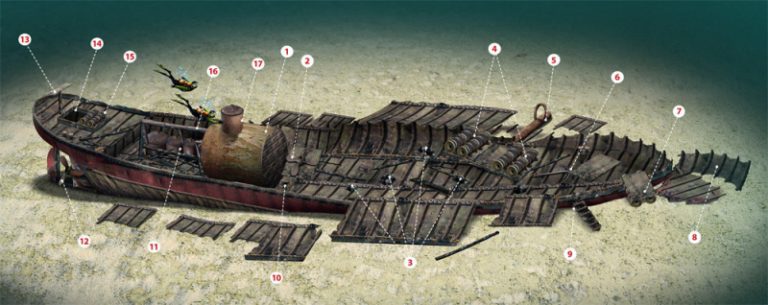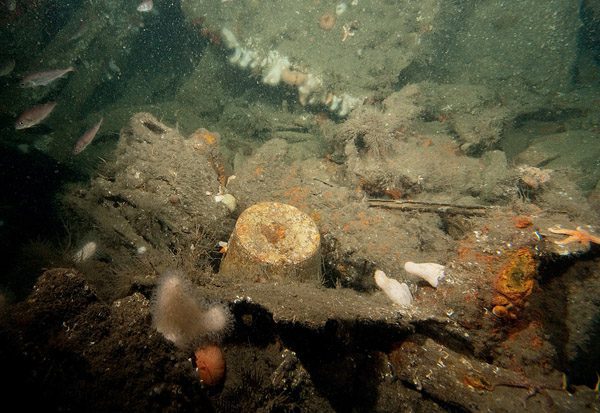This month’s tour of a North Sea WW1 U-boat victim is one for the technical divers, and it’s a fair boat-ride out too. And is it definitely the Aulton? JOHN LIDDIARD wonders if it is just one of many sunken small coal-carrying coasters. Tour illustrated by MAX ELLIS
THIS MONTH’S WRECK gave me a strong sense of déjà vu. When I dived the Aulton in 2011 it was just after the tour of the nearby Havlide was published (Wreck Tour 150, June 2011). The two wrecks are so similar and at the same depth, so while under water
I paid special attention to make sure I had not mistakenly dived the same wreck twice under different names.
Soon after the dive, one of the other divers on the trip was looking through DIVER and exclaimed: “How did he get that in the magazine so soon?” He obviously missed the date on the cover.
Nevertheless, there are enough differences to make me sure there has been no mistake. This is a different wreck. It’s not that big a coincidence. Hundreds of small steam coasters of similar design were built, and many were used to ship coal up and down the coast from the North-east.
I have dived many such steam coasters all around the UK, and many of them have featured as Wreck Tours, so the similarities are not that unusual.
It’s a bit of a cliché, but we start our tour by the big single boiler (1), at a depth of 61m. The shot skipper Iain Easingwood uses is a “cat o’ nine tails”, with each tail threaded with rings of lead. It goes straight down and hugs whatever it lands on such that it won’t pull off accidentally.
Orientation is easy. Behind the boiler the wreck is more built up, and forward it is pretty much flat to the seabed.
Immediately forward of the boiler is a spare propeller (2), attached to either a deck-plate or a bulkhead that has fallen aft. The Havlide also had a spare propeller forward of the boiler, but it was positioned a little further forward.
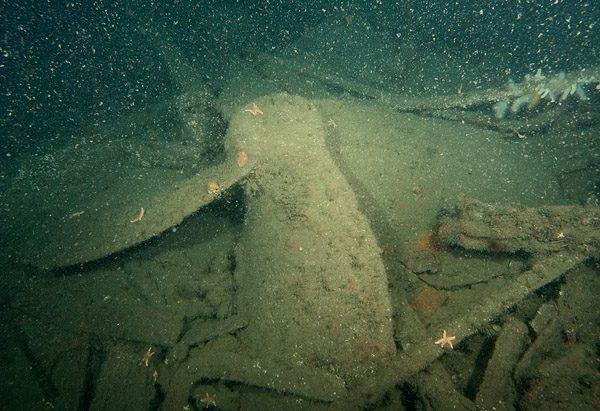
Following across the ribs of the hull forwards, big lumps of coal from the cargo are littered through the hold (3).
Between the two holds, a pair of cargo-winches (4) are attached to a slightly skewed deck-plate. Again, remarkably similar to the Havlide, although there is no monster dahlia anemone on the Aulton.
Then, off slightly to port, this wreck has the stub of a mast (5) with an iron ring to step the wooden upper part.
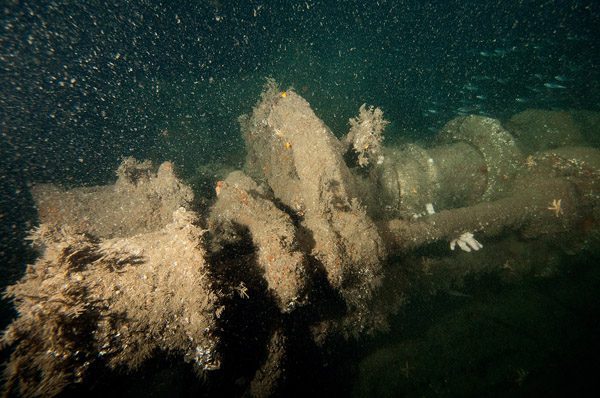
Forward from the winches, an Admiralty-pattern anchor (6) lies at the forward end of the hold.
The wreck now narrows for the bow, with the anchor-winch (7) upside-down and tipped over the starboard side of the bow.
An upper section of the hull from the port side of the bow has been twisted over and now lies straight forward from the stem (8), probably pulled off by a trawler at some time. Seabed level is 62m.
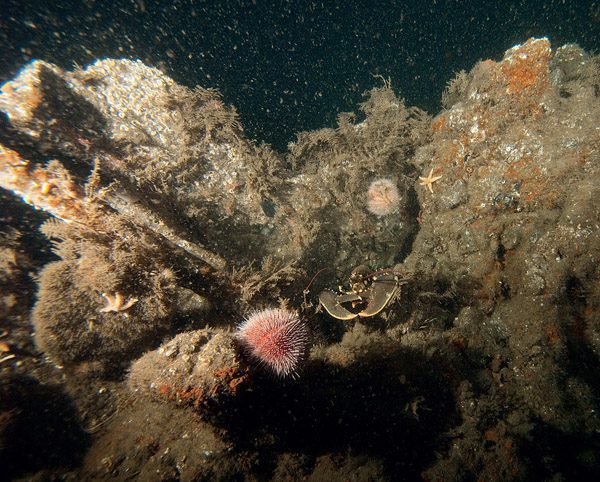
Now heading aft again along the starboard side of the wreck, the remains of a join between deck and bulkhead (9) lies straight out from the side, perhaps pulled there by the same trawl that shifted the section of bow.
Our route crosses the two holds past more scraps of coal and back towards the boiler. Viewing the spare propeller from the starboard side, a small plate protruding from beneath it carries an intact porthole (10).
Behind the boiler the hull is more intact, and rises a couple of metres from the seabed. The Aulton was powered by a triple-expansion engine (11). With the engine at the stern, there is only a short section of shaft before the four-bladed propeller (12). The rudder remains in place and oriented straight ahead.
Ascending the rudder-post, the steering at the top is a simple T-bar (13). Here we come to an anomaly that casts doubt on the identity of this wreck. Records note that the Aulton was fitted with a 12-pounder stern gun, but there is no gun, no gun-mount, and no sign of the damage that a trawl would have caused if it had snagged the gun and dragged it off.
So perhaps this isn’t the Aulton at all. Perhaps it is one of many of the other small coasters lost while carrying coal.
Instead of a gun-mount there is a hatch-coaming (14) to a small aft compartment with a diminutive winch next to it (15).
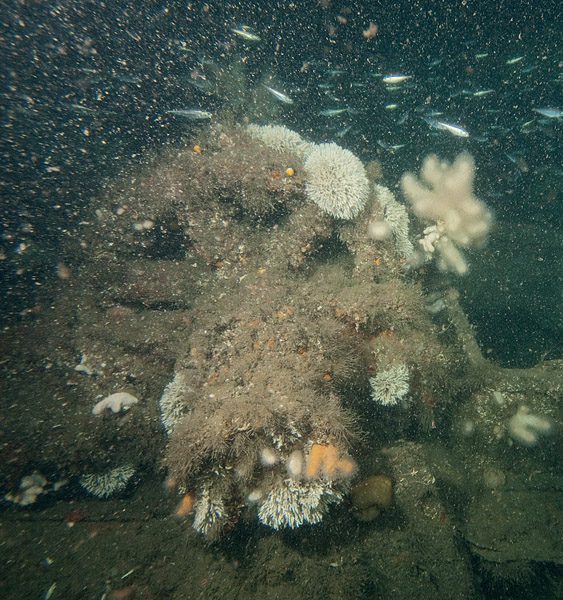
Among the debris below are some large porcelain jars, perhaps once stocked with supplies for the galley.
Finally, our tour rises above the engine to follow a large brass steam-pipe (16) back to the boiler, where the shallowest part of the wreck is the water-separator (17), standing like a dustbin from the back of the boiler.
In this particular instance the dive plan was for everyone to ascend the shotline, with the last diver up then decoupling a lazy shot so that we could all comfortably drift while decompressing.
UB83’S ONLY SUCCESS
AULTON, steam coaster. BUILT 1899, SUNK 1918
ORIGINALLY BUILT IN 1899 by R Williamson & Son of Workington, with machinery by Ross & Duncan of Glasgow, this 634-ton coaster was named Gypsy by her original owner, the Waterford Steamship Co.
Ownership and name changes came often, at first staying in Ireland and then moving on to Scotland. Other names prior to Aulton were Ardenza and Melford.
On 23 March, 1918, the Aulton was owned and operated by Adam Brothers of Aberdeen, carrying coal on a regular run from Seaham for Aberdeen.
At 6.20 in the morning the submarine UB83, commanded by Oberleutnant Günther Krause, put a single torpedo into the Aulton. Two of the crew were killed by the explosion and the remaining 13 safely abandoned ship, to be picked up by a patrol vessel and landed at Berwick. The Aulton sank within five minutes.
UB83, launched in September, 1917, was a small coastal U-boat that in six patrols had remarkably little success. The Aulton was UB83’s only ship sunk.
Later on the same day Oberleutnant Krause put a torpedo into the tanker Meline, which was in ballast, but she survived the explosion.
On 10 September, 1918, UB83 was in turn sunk off the Moray Firth, approximately 42 miles east of Wick, by depth-charges from HMS Ophelia.
Tour Guide

GETTING THERE: Eyemouth is on the A1107, just off the A1. Once in Eyemouth, follow the signs for the harbour. As you enter the harbour area, the Harbourside is on the north side.
HOW TO FIND IT: The Aulton sits upright on a flat seabed with bow to the north. GPS co-ordinates are 55 44.857 N, 001 45.339 W (degrees, minutes and decimals).
TIDES: Slack water comes three hours after high or low water at Eyemouth.
DIVING & GAS: Boat charter company Marine Quest operates from Eyemouth, 01890 752444. It has a full gas facility at the Harbourside.
ACCOMMODATION: The Harbourside offers bunk-room accommodation, lounge, TV, free Internet access and a very efficient drying room for kit.
LAUNCHING: Slip at Eyemouth.
QUALIFICATIONS: A technical wreck dive, but still in the range of normoxic trimix.
FURTHER INFORMATION: Admiralty Chart 160, St Abbs Head to the Farne Islands. Ordnance Survey Map 67, Duns, Dunbar & Eyemouth. Berwickshire Dive Tourism Association. DiveStay.
PROS: Have fun trying to establish beyond all doubt this vessel’s identity!
CONS: A long boat ride, whatever your starting point.
DEPTH: 45m+
Thanks to Iain Easingwood.
Appeared in DIVER November 2013
